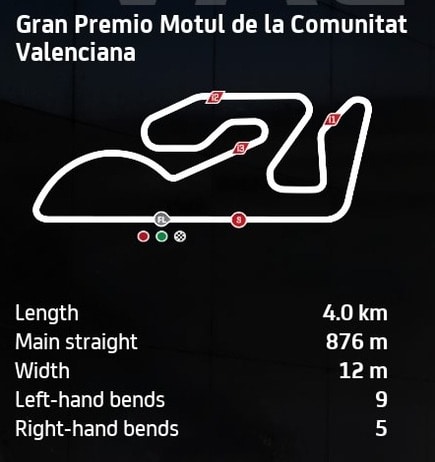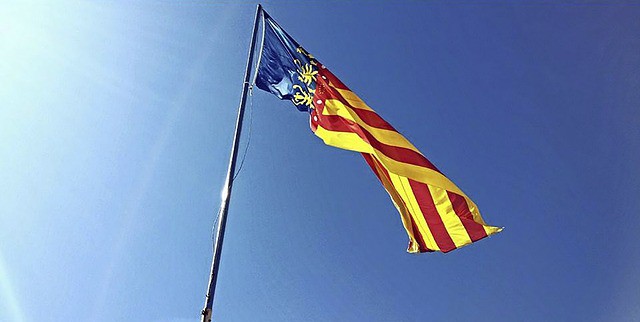I’m not normally a fan of tight, twisty circuits, but the Ricardo Tormo Circuit in Valencia is one of my personal favorites on the MotoGP calendar. It’s got a great flowing rhythm and it’s actually quite an easy track to learn and get comfortable riding.

You’ve only really got the one long pit straight and the rest of the lap is twisty, technical sections. So you need a bike that’s good with braking and turning and has stable handling.
I find this track is one of the easier ones to get comfortable with regardless of setup. However, having one that’s got just the right leaning characteristics for you really helps with the successive corners.
Here’s a MotoGP class bike setup for Valencia:
- Suspension (Front Fork):
-
- Front pre-load – 2
- Oil Quantity – 3
- Front Spring Hardness – 4
- Front Swingarm compression – 3
- Front Swingarm extension – 3
-
- Rear Single Shock Absorber:
-
- Rear Pre-load – 4
- Swingarm connector – 3
- Rear spring hardness – 2
- Single shock absorber compression – 3
- Single shock absorber extension – 3
-
- Vehicle Geometry:
-
- Steering head inclination – 4
- Trail – 4
- Steering plate position – 3
- Rear swingarm length – 5
-
- Transmission:
-
- Gears (1-6) – 5-5-5-4-4-4
- Final ratio – 3
- Slipper clutch – 3
-
- Brakes:
-
- Front disc – 340 mm High Mass
- Rear disc – 220 mm
-
- ECU
-
- Traction control – 5
- Engine braking – 4
- Anti-wheelie – 3
- Power mapping – 2
-
This is just a slight mod of my template setup, but works really well round this track for me.
More advanced players might want to toggle with the ECU settings and use something like 1432 or 2432. But it’s a decent baseline to start with.
Alternative MotoGP Class Bike Setup For Valencia
I also tested another setup, and honestly I couldn’t find much difference between this one and my primary one above. I was setting basically identical lap times, so I’ll be testing and comparing them again next time I race here.
Here’s an alternate MotoGP class setup that also works well round Valencia:
- Suspension (Front Fork):
-
- Front pre-load – 7
- Oil Quantity – 1
- Front Spring Hardness – 6
- Front Swingarm compression – 1
- Front Swingarm extension – 6
-
- Rear Single Shock Absorber:
-
- Rear Pre-load – 6
- Swingarm connector – 2
- Rear spring hardness – 3
- Single shock absorber compression – 4
- Single shock absorber extension – 5
-
- Vehicle Geometry:
-
- Steering head inclination – 4
- Trail – 5
- Steering plate position – 4
- Rear swingarm length – 5
-
- Transmission:
-
- Gears (1-6) – 5-5-5-4-4-4
- Final ratio – 6
- Slipper clutch – 7
-
- Brakes:
-
- Front disc – 340 mm High Mass
- Rear disc – 220 mm
-
- ECU
-
- Traction control – 5
- Engine braking – 4
- Anti-wheelie – 3
- Power mapping – 2
-
This setup uses totally different parameters and can still work well round here, so it’s just a matter of personal preference and which setup feels best for you.
Moto2 and Moto3 Class Setups For Valencia
For the less powerful Moto2 and Moto3 class bikes, check out my generic setups page for starter setups for these bikes that you can test against the game default to find improvements.
Valencia is one of the easier tracks even on the MotoGP class bikes, and even more so for the slower Moto2/Moto3 bikes. Therefore a setup may or may not make much of a difference to you.
Tips For Riding Around Ricardo Tormo Circuit
Valencia is a great circuit to practice on to get used to the new handling on MotoGP 23. The corners follow on from each other in a way that’s really easy to learn, and once you’ve memorized it, it’s a really easy track to stay on the bike and build confidence lap after lap.
Here’s some more pointers for racing round this track.
Restrained on throttle – You can only really open up the throttle on the main pit straight. Everywhere else, it’s all corners closely following each other with just dabs, squirts and short bursts on the power to get to the next braking point. There’s a couple more very short straights, but it’s most about precision on braking and leaning to put a lap together here.
Corner entry/exits – Ricardo Tormo is such a technical track that I’ll break down what you need to do on certain corner exits for MotoGP bikes:
- Turn 1/2 – You can brake later this year (later than where the racing line tells you), as or even just after you reach the red overhead Motul board. Use the front brake and then attack the corner; you can carry a bit more speed into this corner as it widens on the exit. Add a dab of rear brake mid-corner if needed to tuck the bike in. Then, it’s just a short squirt on the power for 1.5-2 seconds before you need to lift off and start braking for the very sharp turn 2 hairpin. Use the rear brake as well as the front to get the bike leaned in.
- Turn 2 exit – Just need the very slightest dab on the power before you need to lean in again for the left hand kink that is turn 3.
- Turn 3 exit – Literally as soon as you take turn 3, come off the throttle and start coasting/braking for turn 4 right hander.
- Turn 4 exit – Very slight dab on the power again before you coast/brake for turn 5.
- Turn 5 exit – Very slight dab again before you brake for the left hand turn 6 onto the short back straight.
- Turn 7/8 – If you get your turn in right, you can take this flat on a MotoGP bike. But literally as soon as you pass T7, come off the power and start braking (front & rear brake) for the sharp turn 8 hairpin.
- Turn 8 exit – Just a very slight dab on the power before you lean in to clip the left right chicane of T9/T10.
- Turn 11 – As you’re going through the chicane, it’s a slight burst of power to push the bike through the longer T11 right hairpin. You can stay narrow or run wide and use some rear brake to turn the bike in to run onto Turn 12.
- Exit Turn 11 – Just a short squirt of maybe 1 second or so out of T11 before you need to coast/brake for turn 12. I use the front brake initially for this, and add some rear if needed to clip the inside kerb a little bit to get on the power quicker for the long loop of Turn 13.
- Exit Turn 12 – Turn 14 – This is like a long looping bowl shaped section that you can take mostly flat if you get your line right. Keep to the middle of the track and keep the bike partially leaned over but not too much. Come off the power and brake for turn 14 once you see the track falling away on your left. Again the rear brake can help get the bike leaned in to get back on the power quickly.

